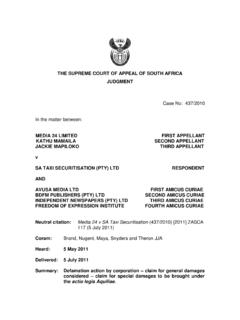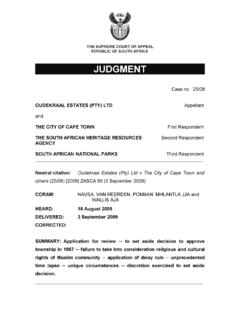Transcription of THE SUPREME COURT OF APPEAL OF SOUTH …
1 THE SUPREME COURT OF APPEAL OF SOUTH africa JUDGMENT Case No: 46/12 In the matter between Not Reportable FAROUK MEYER APPELLANT and THE STATE RESPONDENT Neutral citation: Meyer v The State (46/12) [2013] ZASCA 208 (28 November 2013) Coram: Cachalia, Shongwe, Majiedt JJA Heard: 18 NOVEMBER 2013 Delivered: 28 NOVEMBER 2013 Summary: Criminal law application for special leave to APPEAL .
2 For condonation of the late filing of the application and an application to lead new evidence tests restated evidence of independent witnesses overwhelming on convictions requirements for the presenting of new evidence not met sentence material misdirection by the trial COURT in respect of applicability of the minimum sentence legislation special leave to APPEAL granted against sentence on two murder counts sentence set aside and, upon consideration de novo, life sentences substituted with sentence of 24 years imprisonment.
3 _____ ORDER _____ 2 On APPEAL from: Witwatersrand Local Division (Van Oosten, Snyders and Coetzee JJ, sitting as COURT of APPEAL ): (1) Condonation is granted for the late filing of the application for special leave to APPEAL . (2) The application for leave to APPEAL against the convictions is dismissed. (3) The application for leave to lead new evidence on APPEAL is dismissed. (4) The application for leave to APPEAL against the sentences imposed on counts 3 and 5 is granted. (5) The APPEAL against sentence is partly upheld.
4 The order of the COURT below confirming the life sentences on counts 3 and 5 imposed by the trial COURT is set aside and substituted with the following: (a) The accused is sentenced to 24 years imprisonment on each of counts 3 and 5. (b) The sentences on counts 1, 2, 4, 5, 7 and 8 are to run concurrently with the sentence on count 3. (c) The sentences are antedated to 9 November 2000 . _____ JUDGMENT _____ MAJIEDT JA ( Cachalia and Shongwe JA concurring): [1] The applicant, Mr Farouk Meyer, applies for special leave to APPEAL against a judgment of the full COURT of the Witwatersrand Local Division (as it was then known), by van Oosten J, Snyders and Coetzee JJ concurring (the main application).
5 This judgment, dismissing the applicant s APPEAL against his convictions and sentences by Bam AJ, was delivered on 23 August 2002 and there is consequently an accompanying application for condonation for the late filing of the main application. 3 The applicant also applies for leave to lead new evidence on the merits of his convictions. All these applications were referred for oral argument in this COURT . The applicant prepared his application in person, but procured legal representation at a very late stage to argue the matter.
6 He was legally represented at his trial, in the COURT below and for a period thereafter. [2] The convictions emanate from a shooting incident in a popular night club, Club 12 Play (which actually consists of 2 separate nightclubs), in Roodepoort on 17 October 1999, during which inter alia three persons were shot dead, another one was shot and wounded and a fourth was seriously assaulted. The appellant was convicted for these offences, ie three counts of murder, one count of attempted murder, one count of assault with intent to do grievous bodily harm, unlawful possession of the firearm and unlawful possession of an unknown quantity of ammunition.
7 Sentences ranging from 6 months imprisonment (for the unlawful possession of ammunition) to two life sentences (on two of the murder counts) were imposed. Before I elaborate on the factual matrix underlying the convictions, I deal first with the condonation application. Condonation [3] As is evident from the introductory paragraph above, this application for special leave is being brought some 11 years after the dismissal of the APPEAL in the COURT below. This is an extraordinarily long delay.
8 The explanation proffered by the applicant, namely that he first had to gather proof that (he) was framed and that the evidence that was led during (his) trial was false (in essence the applicant s case in the main application is that the investigating officer, Inspector Coetzee, had manipulated the entire investigation) is not persuasive and is contrary to other objective facts which I do not deem necessary to refer to. The test for condonation entails, broadly speaking, an evaluation in the main of the degree of non-compliance and the explanation therefor as well as the prospects of success (see S v Senkhane 2011 (2) SACR 493 (SCA) at paras 28 and 29).
9 Given the explanation for the long delay, the prospects of success in the main application will be decisive in the condonation application. The merits of the application for special leave to APPEAL against the convictions 4 [4] The determination of reasonable prospects of success on APPEAL has recently been restated by this COURT as follows in Smith v S (2012) (1) SACR 567 (SCA) para 7: What the test of reasonable prospects of success postulates is a dispassionate decision, based on the facts and the law, that a COURT of APPEAL could reasonably arrive at a conclusion different to that of the trial COURT .
10 In order to succeed, therefore, the appellant must convince this COURT on proper grounds that he has prospects of success on APPEAL and that those prospects are not remote but have a realistic chance of succeeding. More is required to be established than that there is a mere possibility of success, that the case is arguable on APPEAL or that the case cannot be categorised as hopeless. There must, in other words, be a sound, rational basis for the conclusion that there are prospects of success on APPEAL .


![2007 Natural and Agricultural Sciences] Part 2 ...](/cache/preview/1/5/6/8/8/a/b/9/thumb-15688ab9cc4402ef9b2339ad72a47048.jpg)










